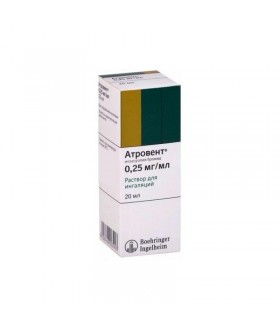




Security policy (edit with Customer reassurance module)

Delivery policy (edit with Customer reassurance module)

Return policy (edit with Customer reassurance module)
Bronchodilating agent. It blocks the M-cholinergic receptors of the smooth muscles of the tracheobronchial tree (mainly at the level of the large and medium bronchi) and inhibits reflex bronchoconstriction, reduces the secretion of the glands of the nasal mucosa and bronchial glands. Having a structural similarity with the acetylcholine molecule, is its competitive antagonist. Effectively prevents the narrowing of the bronchi, resulting from inhalation of cigarette smoke, cold air, the action of various bronchospasm substances, and also eliminates bronchospasm associated with the influence of the vagus nerves. With inhalation use, it practically does not have a resorptive effect - for the development of tachycardia, it is necessary to inhale about 500 doses, while only 10% reaches the small bronchi and alveoli, and the rest settles in the pharynx or oral cavity and is swallowed. The bronchodilating effect develops in 5-15 minutes, reaches a maximum in 1-2 hours and lasts up to 3-4 hours (sometimes - up to 6-8 hours).
Absorption is low. Excreted through the intestines (25% - in unchanged form, the rest - in the form of metabolites). As a derivative of quaternary nitrogen, it is poorly soluble in fats and poorly penetrates biological membranes. In the gastrointestinal tract is practically not absorbed and excreted with feces.The absorbed part (small) is metabolized in the liver into 8 inactive or weakly active anticholinergic metabolites (excreted by the kidneys). Up to 90% of the inhaled dose is swallowed and excreted unchanged, mainly with feces. Does not accumulate.
COPD (with or without emphysema); bronchial asthma (mild and moderate severity), especially with concomitant diseases of the cardiovascular system; bronchospasm during surgical operations, against the background of "cold" diseases. Samples for reversibility of bronchial obstruction; for the preparation of the respiratory tract before the introduction in the aerosols of antibiotics, mucolytic agents, GCS, cromoglicic acid.
Dosed aerosol: for adults and children over 3 years old - for the prevention of respiratory failure in COPD and bronchial asthma - 0.4-0.6 mg (2-3 doses) several times a day (average 3 times), for treatment - additional inhalations can be carried out 2-3 doses of aerosol. Children up to 12 years old in the treatment of asthma (as an adjunctive therapy) - 18-36 mcg (1-2 inhalations), if necessary, every 6-8 hours. Solution for inhalation: adults with bronchitis, emphysema, COPD - 250-500 mcg 3 -4 times a day (every 6-8 hours); asthma - 500 mcg 3-4 times a day (every 6-8 hours). Children from 5 to 12 years old - 125-250 mcg as needed 3-4 times a day.
Dry mouth, increased sputum viscosity. Eye contact - paresis of accommodation, increased intraocular pressure (in patients with angle-closure glaucoma).When using intranasal aerosol - dryness and irritation of the nasal mucosa, allergic reactions.
Hypersensitivity, pregnancy (I term). With care - angle-closure glaucoma, urinary tract obstruction (prostatic hyperplasia), children under 5 years old (solution for inhalation).
It is not recommended for emergency relief of asthma attack (the bronchodilator effect develops later than that of beta-adrenergic stimulants).
Enhances the bronchodilator effect of beta-stimulants and xanthine derivatives (theophylline). The anticholinergic effect is enhanced by anti-Parkinsonian drugs, quinidine, tricyclic antidepressants. With simultaneous use with other anticholinergics - additive effect.